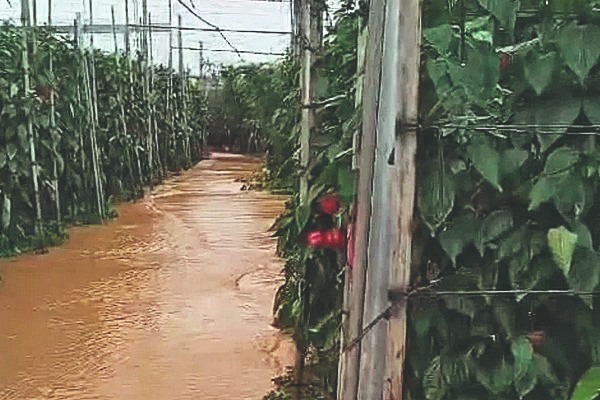A DANA storm hit southern Spain just as the European market was switching to Spanish greenhouse vegetables. Torrential rains followed two weeks later. Despite damage to an estimated 4,000 to 5,000 hectares of greenhouses, supplies remain regular. "There's varying damage," says Jan van der Blom of Coexphal. "But, only very little was severely affected." Elsewhere in Spain, where there are continuing water shortages and less severe damage, that rain was actually considered a positive.
 Spanish Greenhouses in better times
Spanish Greenhouses in better times
Production pressure and falling prices
The Spanish sector had a challenging start to the season. Low prices kept Class II eggplants and cucumbers off the market. Also, greenhouse vegetable production in the first weeks of November was 10-15% lower than last year. Especially distinctive: Cucumber, with prices half as low as last season, despite 30% of the season's production already being harvested. It was 23% for bell peppers, and for tomatoes, only 11%.

Storm damage, photo Jan van der Blom, Coexphal
Els van Herpen, Auction Sales Manager at the Dutch cooperative ZON, says eggplant supplies lagged in late November due to decreased planting. "Supply was limited in the first weeks, partly due to late planting because of virus and pest pressure," adds Ton Bouw of The Greenery. On the DANA's impact, he says, "Supply has recovered. The affected growers, though, remain in an awful situation."
 Storm damage, photo Jan van der Blom, Coexphal
Storm damage, photo Jan van der Blom, Coexphal
Climate becoming increasingly challenging
Besides storm damage repairs, growers found the unseasonable warm November temperatures worrisome. That accelerated production, causing unexpected volumes, especially for cucumbers. Spanish growers work mainly in plastic greenhouses, which are less resistant to climate extremes. Humidifying and chalking are mentioned as solutions. Other growers are investing in high-tech glass greenhouses using Dutch technologies.
 Storm damage, photo Jan van der Blom, Coexphal
Storm damage, photo Jan van der Blom, Coexphal
Tomatoes and competition
Tomato production keeps lagging. This season, attempts were made to bring production forward, partly due to experience with ToBRFV-resistant varieties. Total tomato acreage has been declining for years, with an estimated 14,175 hectares this season, just below last year's 14,320 hectares. Still, higher production is expected, thanks to resistant varieties. Specialty and cherry tomatoes dominate production at 48%. Labor costs remain challenging, accounting for over half of total growing costs.
There is competition from Morocco, especially in the smaller tomato varieties. "Their labor is cheaper, but Spanish quality remains decisive for many customers," says Ton.
 Flooded greenhouse, foto La Vaz de Almeria
Flooded greenhouse, foto La Vaz de Almeria
Looking ahead
Extreme weather like DANA highlights the need for risk spreading. Luc Vanoirbeek of the Belgian Horticultural Cooperatives' Federation calls that storm a wake-up call, saying, "Climate extremes affect all of Europe." Besides Spain, countries like Germany and Poland also experienced floods this year. The Spanish sector will have to further arm itself against water shortages, diseases, and competition from North Africa.
 Jan van der Blom
Jan van der Blom
Coexphal
Dpto. Técnicas de Producción
c/ Esteban Murillo, 3,
04746 El Viso, Almería
Tel.: (+34) 950 558230
Mob: (+34) 609 571802
[email protected]
www.coexphal.es

Els van Herpen
ZON
Venrayseweg 102
5928 RH Venlo
Tel.: +31 (0)77 3239758
[email protected]
www.royalzon.com
 Ton Bouw
Ton Bouw
The Greenery
Mob: +31 612 607 951
[email protected]
www.thegreenery.com
